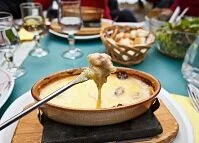Dining Etiquette

Fondue
Dining in Switzerland is based more on the ethnicity of your hosts than by anything else. Your best knowledge base is from the German Food page, French Food page, and the Italian Food page.
However, there are a few rules that should be followed with any of these companions. You should bring a gift such as chocolates or a local wine, but be careful to get a local wine. Plus, alcohol is commonly served with meals so be prepared to drink. The final commonality among all ethnicities in Switzerland is that these groups tend to be more formal in dining, from dress to manners so dress nicely and use high standard table manners.
Unfortunately, nearly everything else differs, from when to arrive and the food to what kind of alcohol will most likely be served so continue on to the German Food page, French Food page, and the Italian Food page.
Most restaurants and bars include a service charge in your bill, but if not, about 10-15% is standard in regards to tipping. When tipping at a restaurant though, never leave the money on the table, instead give the money to the server and tell them how much you want to pay (bill and tip included).
Drinks
Switzerland has a heavy bias towards milk products and this holds true with rivella, a carbonated milk-based drink. They are also well-known for their apple juices, which can be served in a number of ways and prepared both with or without alcohol. Of course if you're looking for more familiar drinks, milk, coffee, tea, and juices are all widely available.
As a crossroads of German, Italian, and French cultures, Switzerland boasts both great wines and beers; some locally produced, others imports from these neighbors. If you don't want these local products, international beers, wines, and hard liquors are all widely available.
Generally speaking, the tap water is safe to drink in Switzerland, but check with locals for any particular regional differences. Also, many people may have troubles adjusting to the local tap water, as it will most certainly be different from what your system is used to.